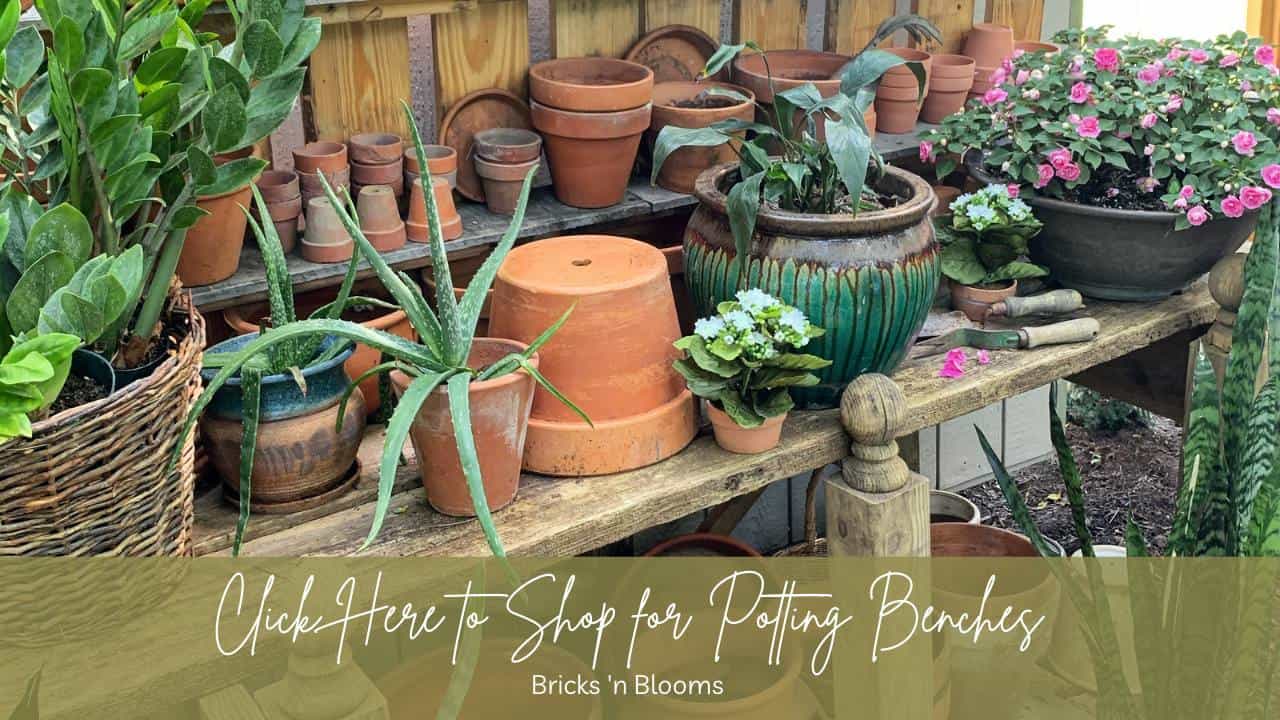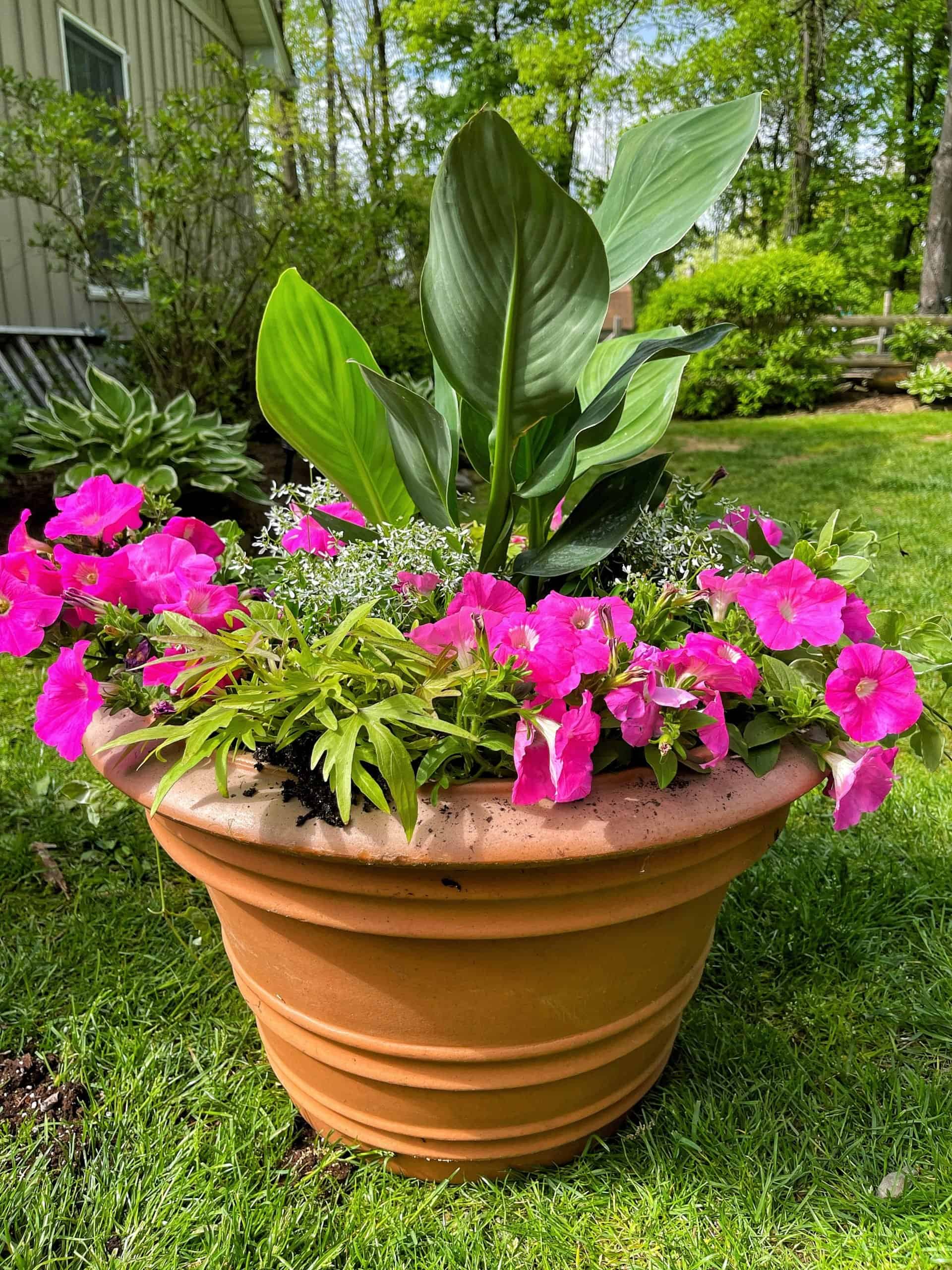New to gardening? Learn easy container gardening for beginners! No green thumb required – this simple guide will have you growing beautiful plants in no time.
New to gardening? Perfect! Container gardening is the absolute best way to start, and you’re in the right place. Don’t worry if you’ve never planted anything before – I’ll walk you through every step, from choosing your pots to watching your plants thrive. Let’s dig in and create your own little green escape with lots of blooms, no matter how small your space!
(Posts on stacyling.com may contain affiliate links. Click HERE for full disclosure.)
Container Gardening for Beginners – Spring Planting Ideas
Container Gardening For Beginners: The Many Benefits
Why choose container gardening? For beginners, it’s a fantastic way to start! Whether you have a tiny balcony or simply want to add pops of greenery to your space, containers offer amazing flexibility. As a master gardener, I love how they allow me to maximize my planting, and you can apply these benefits to herbs and vegetables, too!
Here are the key advantages.
- Space-Saving: Turn any small area—balcony, patio, windowsill—into a thriving garden.
- Total Control: Fine-tune sunlight, soil, and water to perfectly suit your plants’ needs.
- Creative Freedom: Design stunning plant combinations and personalize your garden’s aesthetic.
- Moveable Gardens: Easily reposition plants for optimal sunlight or protection from the elements.
- Extended Growing Season: Bring containers indoors to enjoy your plants year-round.
- Simplified Maintenance: Enjoy easier weeding, watering, and overall care.
Container gardening is the perfect gateway to growing your own green space, no matter how small. Ready to get started?


Container Gardening for Beginners: How to Design the Prettiest Planter
Container gardens are super fun to design. It is one of my favorite things to do because you can play around with many different flowers, textures, and dimensions in the porch planters. Whether you keep your planter ideas simple or create something more elaborate, they are the perfect addition to both indoor and outdoor living spaces.
Choose the Perfect Container For Your Garden
Before you buy any plants, decide on the style, color, and size of your containers. For vibrant annual displays on patios and porches, I recommend larger pots. They hold more plants, retain moisture better (meaning less watering!), and make a bigger visual impact – and who doesn’t want more blooms?
Don’t limit yourself to garden center options! I love thrifting for unique containers at flea markets and antique stores. You can find some truly special pieces, like this thrifted find I repurposed for my porch.

Container Options: A Quick Guide
Here’s a breakdown of common container types to help you choose:
- Terra Cotta: Beautiful, but can be pricey, heavy, and dry out quickly.
- Glazed Ceramic: Similar to terra cotta but retains moisture better. Can be expensive.
- Plastic: Affordable and lightweight. Choose thicker, durable options for longevity.
- Wood: Great for raised beds or DIY projects.
- Cement: Durable but heavy, best for permanent placements.
- Self-Watering: Feature a water reservoir for consistent root watering and less soil use.
Drainage is Essential!
Unless you’re using self-watering planters, drainage holes are a must. They prevent waterlogging, root rot, and disease. Most containers come with them, but if yours doesn’t, you’ll need to add some.

Designing Your Color Scheme & Plant Selection
Creating a beautiful container garden is all about choosing the right plants and colors! For a stunning look, try the “thriller, filler, and spiller” technique – it’s a simple way to design like a pro.
The Rule of Thumb: Keep plant size in proportion to your pot. For tall containers, the tallest plant should be about 1-2 times the pot’s height. For wider, bowl-shaped pots, match the plant height to the width.
Shopping Tips
Don’t be afraid to experiment with colors and textures at the nursery. Use your cart to mock up arrangements if you don’t have your pot with you. And consider your garden’s location. Sun-loving plants won’t thrive in shade, and vice versa.

Plant Ideas for Your Containers: Examples
- Flowers: Petunias, geraniums, marigolds, calibrachoa, zinnias, impatiens, pansies, begonias.
- Vegetables & Fruits: Tomatoes, peppers, lettuce, cucumbers, squash, strawberries, blueberries, dwarf citrus trees.
- Herbs: Basil, rosemary, thyme, parsley, chives, mint, oregano, cilantro.
- Succulents and Cacti
- Shrubs: Hydrangeas, boxwoods, roses, and so many more.
- Perennials: Hostas, coneflowers, sedums, rudbeckia, lavender, nepeta tickseed are all great options.
- Small trees: apples, espaliers, lemon, pear, dogwood, hydrangeas and more.
- Climbers/Vines: Clematis, roses, hydrangea, honesuckle
- Ornamental Grasses
- Houseplants
When selecting plants for containers, consider their mature size, growth habits, and container size needed to accommodate their root systems. If choosing trees or shrubs, seek out dwarf varieties where possible to ensure they won’t outgrow their containers too quickly. It’s also a good idea to pay attention to sunlight and water requirements to ensure they thrive in their container environment.
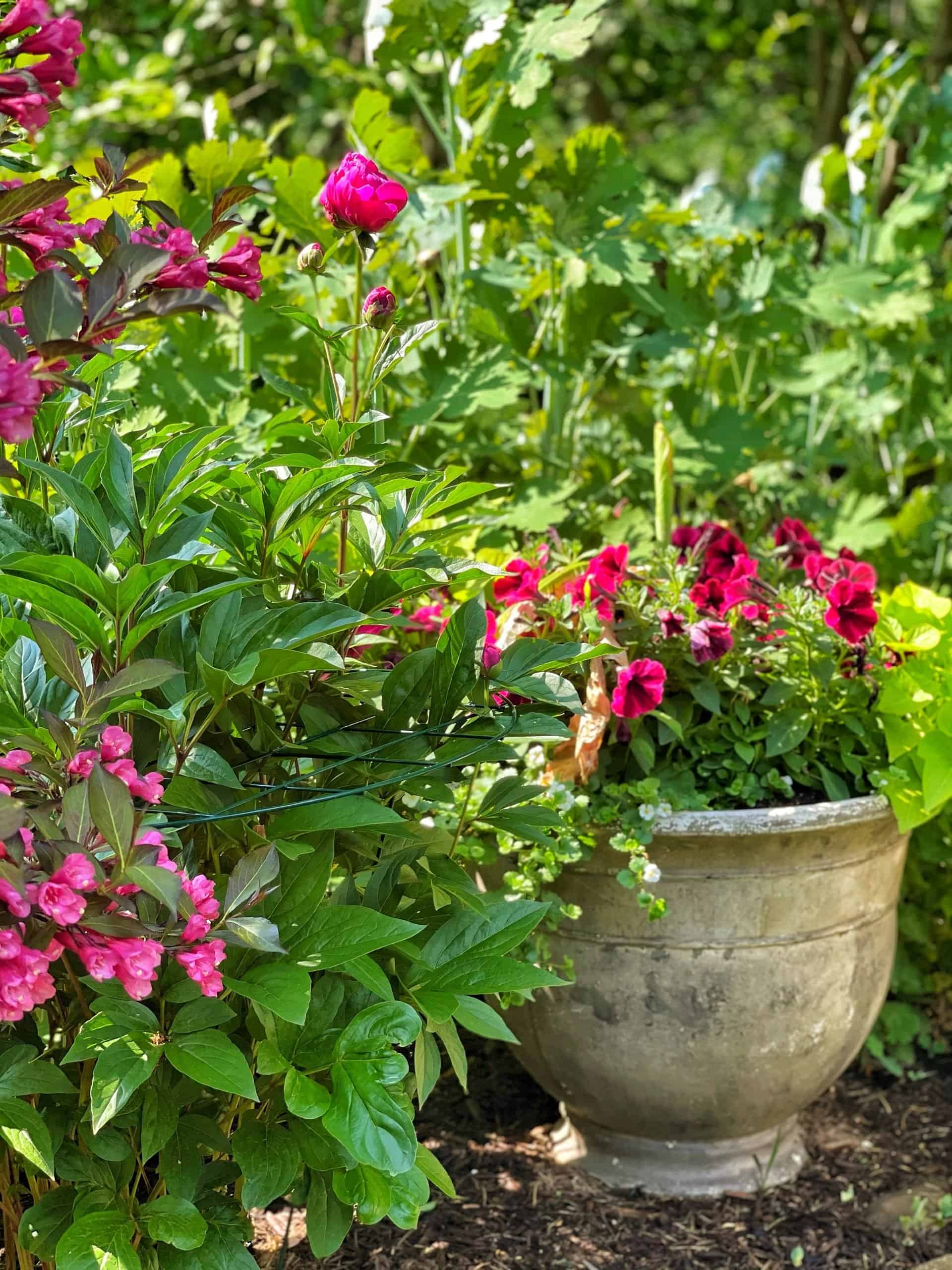
How Many Plants?
- Plant in odd numbers for a more visually pleasing look.
- If unsure, round up when buying plants. You can always add an extra, but returning to the nursery is a hassle.
- If you want a full look right away, feel free to add extra plants. Don’t be shy about stuffing them in there to get a full look.
Thriller, Filler, and Spiller Plant Ideas
- Thrillers (Height & Drama): Dracaena, calla lilies, ornamental grasses, colocasia, caladium.
- Fillers (Fill the Space): Marigolds, petunias, pansies, begonias.
- Spillers (Cascade Over the Edge): Bacopa, petunias, lantana, creeping jenny, sweet potato vine.
To learn more about how to use the thriller, filler and spiller method, read my article her.

Container Gardening for Beginners: Matching Plants to Light in Container Gardens
One of the best things about container gardening is that you can grow full sun, partial-sun, and full shade plants all on the same property! While an in-ground garden has to be carefully planned based on natural light, containers can be placed anywhere in your yard or patio and can even be moved around if needed.
Pro-Tip: Make sure you choose plants that have the same light and watering requirements in the same pot.
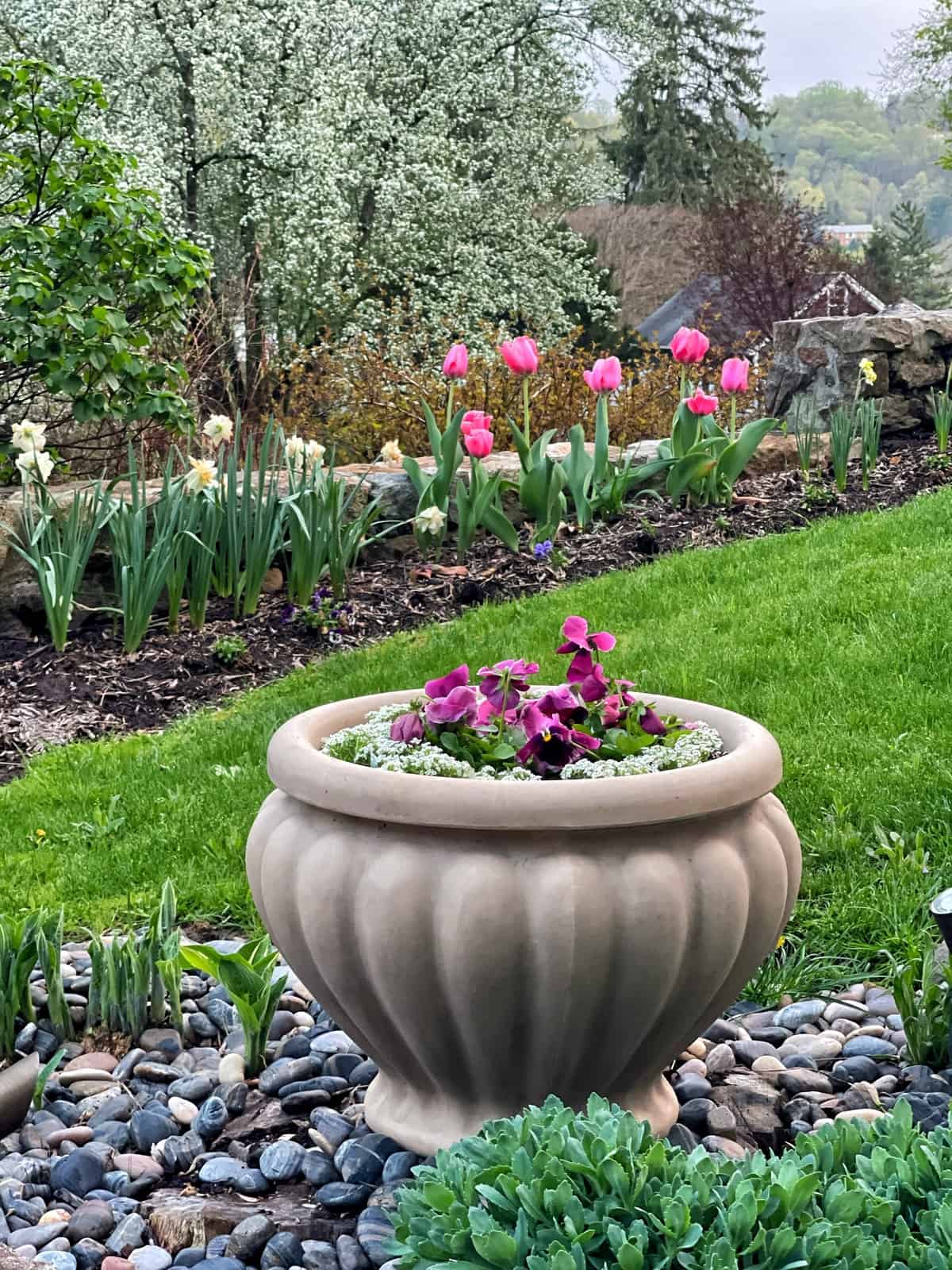
Step 4: Nourish Your Plants with Fresh Potting Soil
Healthy soil is key to a thriving container garden! Whether you’re starting fresh or reusing a pot, make sure you’re working with nutrient-rich potting soil. I love to use this potting soil because it is a great blend mixed with lots of compost and other organic matter that gives new plants a fresh start.
Why Fresh Soil Matters
Watering your potted flowers washes away soil nutrients, which plants need for growth and blooms.
Pro-Tip: If you’re reusing a container, replace about half of the old soil with fresh potting mix.
Planting Tips
- Use Some Weed Fabric: Line the inside of your pot with weed fabric to prevent soil from escaping through drainage holes.
- Lightweight Containers: Fill the bottom 1/4 of your XL pots with crushed plastic nursery pots before adding soil. This reduces weight and makes moving large containers much easier.

Fertilizing Your Container Garden
- Why Fertilize? Container plants rely on you for nutrients, as they don’t have access to the ground’s natural resources.
- Slow-Release Fertilizer: Use a balanced, slow-release fertilizer like this designed for containers. This provides a steady supply of nutrients and it’s set and forget.
- Bloom Booster: Consider adding a bloom booster like this one during the growing season to encourage more flowers.
- Monitor Your Plants: Watch for signs of nutrient deficiency (yellowing leaves, stunted growth) or over-fertilization (burnt leaf tips) and adjust as needed.
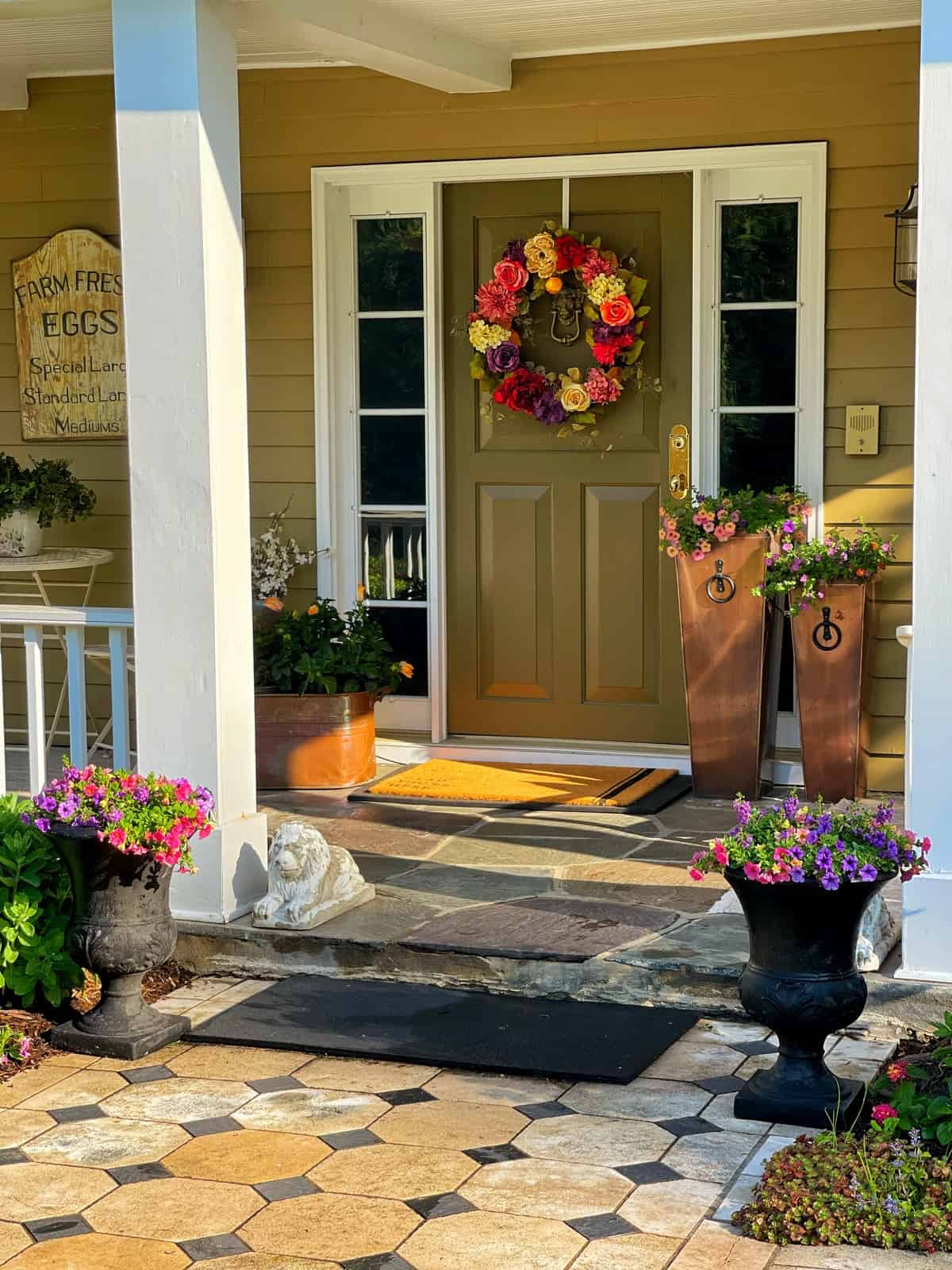
Step 5: Container Garden Design 101 – Tips for Beautiful and Thriving Arrangements
When the container is ready for planting, start stuffing it with the thriller, filler, and spiller planting technique. While working, step back a few times to see that the container has symmetry, balance, and fullness. Since I like to stuff plants in containers – there is usually no room left in a pot after I plant.
But if you want to take it a step further, you could add natural elements such as bows, raffia, wicker, birdhouses, etc. Do what you love and most importantly, have fun with it! Because that’s part of the joy of gardening.

Container Gardening for Beginners: Nurturing Your Planters for Year-Round Success
Watering Container Gardens
- Outdoor containers need regular watering, especially in hot weather.
- The best way to know when to water is to check the soil. Stick your finger 1-2 inches down; if it’s dry, water.
- Consider using a drip irrigation system with a timer for easy watering, especially if you have many containers.
- Water at the base of plants in the morning to prevent disease.
My Watering Hack for Container Gardens
Many of us know about drip irrigation systems for in-ground gardens, but did you know that there are easy kits you can buy for your planters too? Drip irrigation kits set on timers are total game changers where planting in containers is concerned. If you have a lot of planters, you could literally spend hours watering in the summer if you don’t set up some sort of drip irrigation system for them.
I run these drip irrigation kits to all of my containers that include planters, hanging baskets, and window boxes set on timers so they are easy to care for all season long. I check them frequently to make sure they aren’t getting over or under-watered. And if they need adjusting, I adjust!
But overall these kits are super easy to install, use, and are MUST-HAVES if you garden with any sort of planters because they will significantly cut down on your watering chores.
To accommodate the drip system and still be able to use a garden hose, I use these two or four-way hose splitters too. These additions to my gardens has quite literally changed my gardening life with how well they bloom and grow. So I can’t recommend these enough.
Note: You may need to adjust the timing of hose timers throughout the season to accommodate seasonal and climate conditions.

Deadheading
- Remove spent flowers to encourage more blooms and keep plants tidy.
- Deadheading also redirects nutrients for stronger, healthier plants.
While deadheading may not be necessary for every flowering plant in a container garden, incorporating this practice into routine maintenance can help maximize the beauty and overall health of your containers.
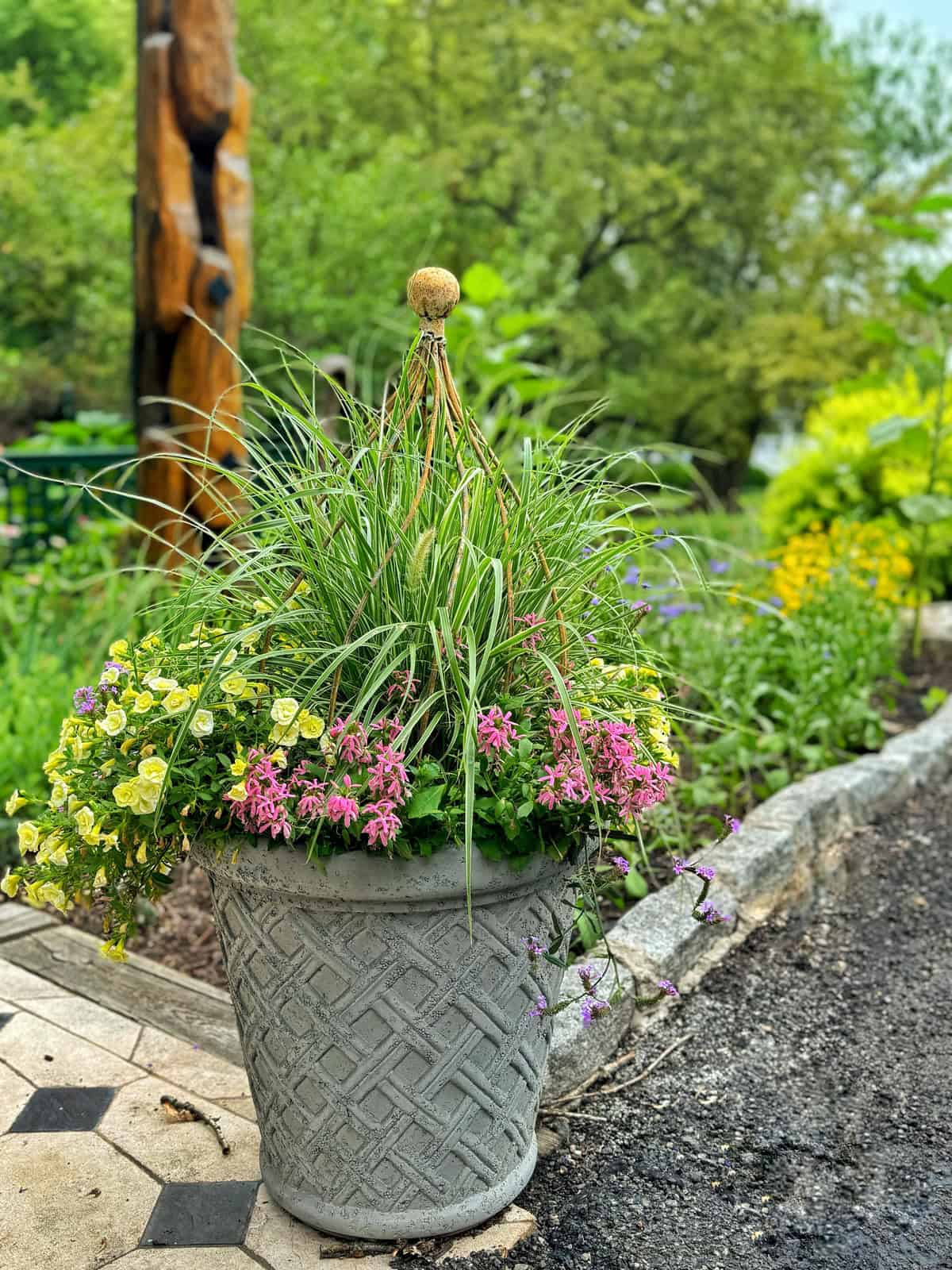
How to Keep Pests Out of Your Container Garden
Just like any garden, container gardens can easily fall prey to squirrels, birds, bunnies, deer and insects looking for a tasty bite.
Here are a few simple tips to keep pests at bay:
- Choose deer-resistant plants and bulbs.
- Try making an all-natural garlic spray with water, vinegar, and chopped garlic or sprinkle cayenne pepper powder around plants to help keep wildlife at bay. Or you can buy deer repellents like this one that help keep other wildlife away as well.
- Strategically place wind chimes or motion-activated sprinklers to startle deer, bunnies, and other wildlife and keep them away from your plants.
- Nets and cages that cover containers can also help keep birds and squirrels from digging or eating seeds. Consider placing your containers inside fenced patios or even bringing your plants inside overnight for extra protection.

Overwintering Potted Plants
In colder climates, overwintering plants in containers can be more challenging than those in the ground. Pots can freeze and damage the roots of plants, leading to their demise. Use porch planters that can withstand a range of weather conditions like resin or move potted plants indoors in a location where they will receive some protection in colder climates.
Tips for Growing Perennials, Shrubs, and Small Trees in Post All Year Round
Choose plants rated two zones hardier than your own for successful overwintering. So if you live in Zone 6, plants should be hardy to zone 4.

Final Thoughts on Container Gardening
Whether you’re a complete beginner or a seasoned gardener with limited space, container gardening offers a world of possibilities. It’s the perfect starting point for anyone wanting to dip their toes into growing, allowing you to cultivate flowers, herbs, or even vegetables in a single, manageable pot. Keep it simple and enjoy the satisfaction of nurturing your own little green space.
Or, if you’re looking to transform your outdoor living area into a vibrant oasis, container gardening allows you to fill every corner with an abundance of blooms and greenery. The flexibility to arrange and rearrange pots means you can constantly refresh your space and create stunning visual displays. No matter your goal, container gardening provides an accessible and rewarding way to bring the beauty of nature right to your doorstep.

For more information about container gardening, please see this article from the University of California Santa Clarita Master Gardeners article.
Are you growing any potted flowers or vegetables this year? Let’s chat more about it in the comments below.
To drill down on more beginner gardening techniques and tips, please read these posts:
Thanks for stopping by the blog today!
Enjoy your day! xoxo


The Best Way to Pot a Plant
The best way to pot a plant is from an upright position. For years, I was bending over and planting containers from the ground. But then I started using a potting bench, and it is so much easier to plant a container garden that way! If you don’t have one, consider using a folding table or something to raise those outdoor planters and containers off the ground while you work.
